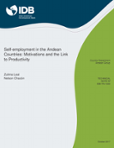Self-employment in the Andean Countries: Motivations and the Link to Productivity
Date
Oct 2017
We look at the possible channels in which self-employment can harm productivity outcomes in the Andean region and the motivations that incentive workers to opt for self-employment. We estimate quantile regressions with the purpose of identifying whether there is a monetary income premium for those at self-employment compared to wage earners at various levels of income. We find that there is a negative income premium for self-employed workers at the bottom 25% of the income distribution in the Andean countries, except for Venezuela, where although there is a positive income premium, the magnitude is very small to generate enough incentive to prefer self-employment. Our estimations also indicate that self-employed workers at the top 25% of the income distribution have larger positive income premiums. The evidence suggests two types of self-employed workers, one composed of higher income earners, and the other one by most workers, that given the absence of formal job opportunities choose self-employment, but would be better off in terms of income as dependent workers.



